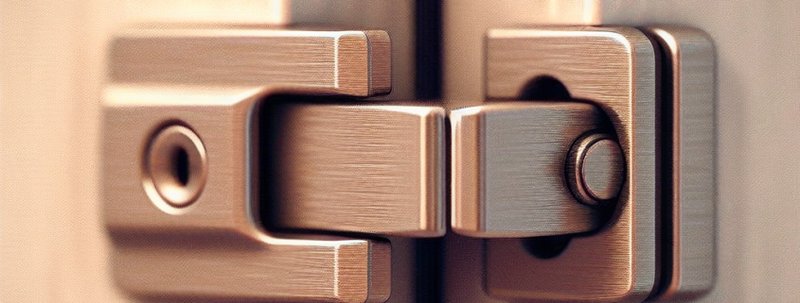
There are many reasons why your door latch bolt might not be extending properly. You could be dealing with something as minor as dirt build-up, or it could be an alignment issue. Let’s dive into this problem, breaking it down step by step, so you can understand why this happens and, more importantly, how to fix it.
Understanding How Door Latch Bolts Work
To get to the bottom of the issue, it helps to know how a door latch bolt operates. Think of it as a tiny arm that needs to push out to secure your door, just like a hand reaching out to grab a handle. When you turn the knob, a mechanism activates that should extend the latch bolt into the door frame, securing it in place.
If everything is working correctly, this action brings a satisfying click. However, if the latch bolt isn’t extending far enough, there’s a hiccup in this process. It could be anything from misalignment to mechanical failure. Understanding this basic operation sets the stage for troubleshooting.
The Components Behind the Latch Mechanism
The latch bolt system consists of several key parts: the bolt itself, the spring that pushes it, and the handle or knob that activates it. If any one of these components is malfunctioning, it could cause the latch bolt not to extend fully. For example, if the spring is weak or the bolt is stuck due to dirt or rust, it might not reach far enough into the door frame to engage.
Here’s a helpful analogy: Imagine trying to push a heavy door open with a weak arm. No matter how hard you try, if your strength isn’t enough, the door won’t budge. Similarly, if the components of your latch aren’t doing their job, you’ll run into problems.
Common Reasons Your Latch Bolt Isn’t Extending
It’s time to take a closer look at some common culprits that might be causing your door latch bolt not to extend properly. Each problem has its own solution, so knowing what you’re dealing with is key.
- Dirt and Debris: Over time, dirt, dust, and grime can accumulate in the latch mechanism, causing it to stick.
- Misalignment: If your door or the latch isn’t properly aligned with the strike plate, the bolt might not reach far enough.
- Worn Components: Like all things, latches can wear out. A rusty or weak spring can mean your bolt won’t extend fully.
- Weather Changes: Changes in humidity or temperature can affect wood doors, causing them to swell and misalign.
Let’s take a deeper look at each of these points to understand how you can troubleshoot your door latch issue effectively.
Dirt and Debris Blockage
You might be surprised how often dirt and debris cause latch problems. Over time, dust can settle in the latch area, creating a barrier that prevents smooth operation. If you notice the latch bolt is getting stuck or feels stiff, try cleaning it first.
Here’s how to do it:
1. Remove the latch plate: Unscrew it from the door frame.
2. Clean the area: Use a damp cloth to wipe away any dirt or grime. You can also use a small brush to get into tight spots.
3. Lubricate: Once it’s clean, apply a silicone-based lubricant to ensure smooth operation.
This simple maintenance step can make a world of difference!
Checking for Misalignment
Misalignment is a frequent issue, especially if your door has recently been adjusted or if it’s an older door. When the door isn’t aligned properly, the latch bolt may not reach the strike plate correctly. This issue can often be spotted quickly by visually inspecting the door.
How to Check Alignment
1. Close the Door: Stand back and observe if there is a gap between the door and the frame.
2. Examine the Strike Plate: Look for wear marks where the bolt should engage the plate.
3. Adjust Hinges: If the door hangs lower on one side, adjust the hinges slightly to shift it back into the correct position.
Making these adjustments is usually straightforward and can resolve the problem quickly.
Worn Components and Replacement Options
If your latch has seen better days, it might be time for a replacement. Over time, parts can wear down due to constant use leading to inadequate performance of the latch.
When to Replace the Latch
– If the latch bolt is visibly damaged or bent.
– If cleaning and aligning the latch do not fix the issue.
– If the spring appears rusted or broken.
You can find replacement latches at local hardware stores, and many of them are easy to install with basic tools. Make sure to select a latch that matches your door style for the best fit.
Weather-Related Issues
Believe it or not, the weather can play a significant role in how well your door functions. Humidity can cause wooden doors to swell, impacting the alignment of the latch and strike plate.
What to Do About Weather Swelling
If you suspect swelling is the issue:
1. Monitor the Season: Sometimes, the problem resolves itself as the weather changes.
2. Regular Maintenance: Keeping your door well-sealed can help prevent moisture absorption.
3. Adjust as Needed: If swelling continues, you may need to adjust the strike plate or trim the door edges to ensure a better fit.
Taking these steps can keep your door functioning well, regardless of the weather outside.
Wrap-Up: Ensuring a Properly Functioning Latch
Getting your door latch mechanism to work correctly might take a little detective work, but it’s worth the effort. Whether it’s cleaning, adjusting, or replacing components, addressing the issue promptly ensures your door remains secure. Remember, a properly functioning latch isn’t just a convenience; it’s essential for home security.
So, next time you’re facing that stubborn latch bolt, you’ll know just what to look for and how to tackle the problem. Keeping your door in good shape not only provides peace of mind but also saves you from those frustrating moments of uncertainty.